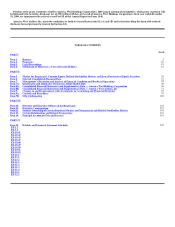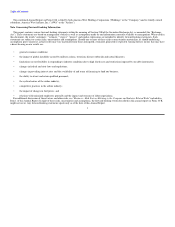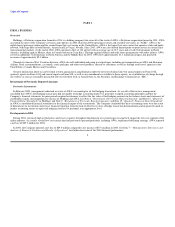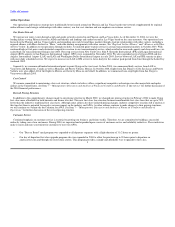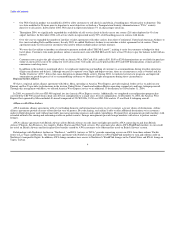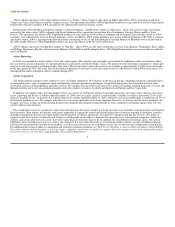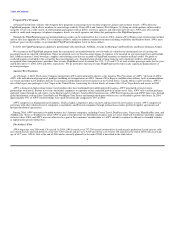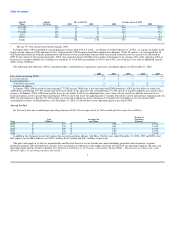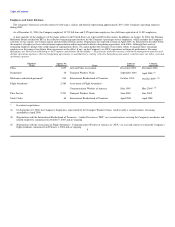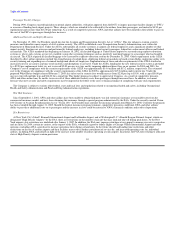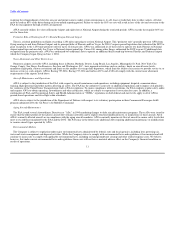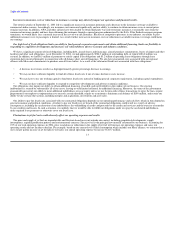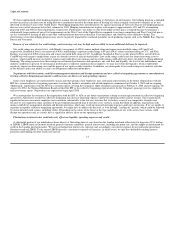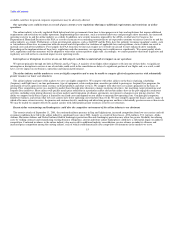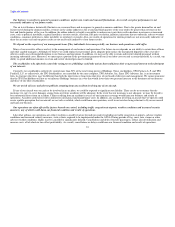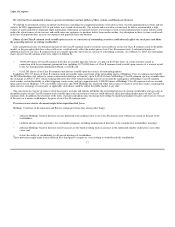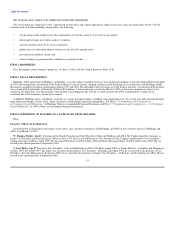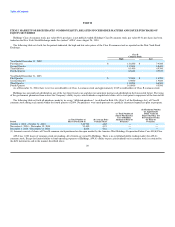US Airways 2004 Annual Report Download - page 13
Download and view the complete annual report
Please find page 13 of the 2004 US Airways annual report below. You can navigate through the pages in the report by either clicking on the pages listed below, or by using the keyword search tool below to find specific information within the annual report.
Table of Contents
Passenger Facility Charges
During 1990, Congress enacted legislation to permit airport authorities, with prior approval from the DOT, to impose passenger facility charges or "PFCs,"
as a means of funding local airport projects. These charges, which are intended to be collected by the airlines from their passengers, are limited to $4.50 per
enplanement and no more than $18.00 per round trip. As a result of competitive pressure, AWA and other airlines have been limited in their ability to pass on
the cost of the PFCs to passengers through fare increases.
Additional Security and Safety Measures
On November 19, 2001, the President signed into law the Aviation and Transportation Security Act or "ATSA." This law enhances aviation security
measures and federalizes many aspects of civil aviation security. The ATSA established a new Transportation Security Administration, now within the
Department of Homeland Security. Under the ATSA, substantially all security screeners at airports are federal employees and a significant number of other
airport security functions are overseen and performed by federal employees, including federal security managers, federal law enforcement officers and federal
air marshals. The ATSA mandated that beginning on January 18, 2002, all checked baggage at United States airports be screened using explosive detection
systems or, where such systems are not yet available, using other screening techniques such as positively matching baggage to a passenger who has boarded
an aircraft. The ATSA required all checked baggage to be screened by explosive detection systems by December 31, 2003. Other requirements in the ATSA
that directly affect airline operations include the strengthening of cockpit doors, deploying federal air marshals on board certain flights, improving airline crew
security training and expanding use of criminal background checks of employees. Implementation of these and other requirements of the ATSA resulted in
increased costs for air carriers and may result in delays and disruptions to air travel. Under the ATSA, funding for the new federal security system is provided
by a $2.50 per enplanement ticket tax, not to exceed $5.00 per one-way trip, and by imposing additional direct fees on air carriers. In 2004 and 2003, the
Company's cost of compliance with the security requirements of the ATSA was approximately $14.4 million and $13.2 million, respectively. The estimated
cost to the Company of compliance with the security requirements of the ATSA for 2005 is approximately $17.0 million under current law. Under the
proposed White House budget released February 7, 2005, this ticket tax for security fees would increase from $2.50 per leg to $5.50, with a cap of $8.00 per
one-way trip with multiple legs and $16.00 for a round trip. This budget proposal is subject to approval of Congress. As a result of competitive pressure,
AWA and other airlines may be unable to recover all of these additional security costs from passengers through increased fares. In addition, we cannot
forecast what new security and safety requirements may be imposed in the future or the costs or financial impact of complying with any such requirements.
The Company is subject to various other federal, state and local laws and regulations related to occupational health and safety, including Occupational
Health and Safety Administration and Food and Drug Administration regulations.
War Risk Insurance
Since September 11, 2001, AWA and other airlines have been unable to obtain third party war risk (terrorism) insurance at reasonable rates from the
commercial insurance market and have been obtaining this insurance through a special program administered by the FAA. Under the recently enacted Vision
100-Century of Aviation Reauthorization Act or "Vision 100," the President may continue the insurance program until March 30, 2008. Currently the program
has been extended through August 31, 2005. Should the federal insurance program terminate, competitive pressures could limit AWA and other airlines'
ability to pass these additional costs on to passengers and the increase in costs could be material to AWA's financial condition and results of operations.
Slot Restrictions
At New York City's John F. Kennedy International Airport and LaGuardia Airport, and at Washington D.C.'s Ronald Reagan National Airport, which are
designated "High Density Airports" by the FAA, there are restrictions on the number of aircraft that may land and take-off during peak hours. At the New
York airports, slot restrictions are abolished after January 1, 2007. In addition, the FAA may impose restrictions at any airport to manage excessive congestion
and air safety. In 2004, certain air carriers, at the request of the FAA, voluntarily agreed to reduce flights at Chicago O'Hare International Airport and other
operators, including AWA, agreed not to increase operations there during certain hours. In the future takeoff and landing time restrictions and other
restrictions on the use of various airports and their facilities may result in further curtailment of services by, and increased operating costs for, individual
airlines, including AWA, particularly in light of the increase in the number of airlines operating at such airports. In general, the FAA rules relating to allocated
slots at High Density Airports contain provisions
10


